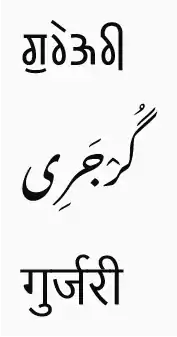Gujari language
Gurjari, also known as Gujri (गुर्जरी, گُوجَری) is a variety of Indo-Aryan spoken by the Gurjars and other tribes of India, Pakistan, and Afghanistan.[2][3]
| Gurjari | |
|---|---|
| Gojri, Gurjari | |
| गुर्जरी, گُوجَری | |
 | |
| Native to | India, Pakistan, Afghanistan |
| Region | Rajasthan, Haryana, Western Uttar Pradesh, Madhya Pradesh, Kashmir, upper Khyber Pakhtunkhwa, southeastern Afghanistan |
Native speakers | (1 million cited 1992–2000)[1] |
Indo-European
| |
| Takri, Nastaliq script, Devanagari | |
| Language codes | |
| ISO 639-3 | gju |
| Glottolog | guja1253 |
The language is mainly spoken in Jammu and Kashmir, Himachal Pradesh, Haryana, Uttarakhand, Rajasthan, Gujarat, Punjab, Delhi and other parts of India. The government of Jammu and Kashmir has recognized Gujari by including it in the sixth schedule of the state constitution.[4]
The language is understood by Gujjars across Pakistan and spoken in upper or hilly areas including Hazara Division, Malakand Division, Peshawar Division, Azad Kashmir and Gilgit-Baltistan. In Pakistan, a number of organisations and institutions work for the development of Gujari, including a Gujari language news channel.
It is spoken in two provinces in southeastern Afghanistan.
Literary traditions
Gujari folklore includes songs, ballads and folktales, known as Dastans. Hundreds of folk songs have been recorded and published, including "Nooro", "Tajo", "Nura Beguma", "Shupiya", "Kunjhdi", "Mariyan".
A modern tradition of creative writing encompasses poets such as Sain Qadar Bakhsh, Noon Poonchi, and others. Others such as Mian Nizam ud Din, Khuda Bakhsh Zar, Zabih Rajourvi, Shams ud Din Mehjoor Poonchi, Mian Bashir Ahmed, Javaid Rahi, Rafiq Anjum, Milki Ram Kushan, Sarwari Kassana, Naseem Poonchi have also made remarkable contributions to Gujari through poetry, prose and criticism.
Institutions and media
All India Radio and Doordarshan Kendra run various Gujari programmes. Radio Kashmir Jammu, Srinagar, Poonch in India and seven Radio Stations of Pakistan and PTV air Gujari programmes and news bulletins accepted across Jammu and Kashmir. Books have been published in Gujari, including encyclopedias, poetry, fiction and non-fiction, on topics including dictionaries, grammars, nature, folklore, art and architecture, agriculture, sociology and research.
The National Academy of Letters, Sahitya Akademi, recognized Gujari as one of the major Indian languages for its National Award, Bhasha Samman, and other programmes. The Jammu and Kashmir Academy of Arts, Culture and Languages established a Gujari Department in its Central Office in the 1970s and published in Gujari. They organized seminars, conferences, etc. for the development of the Gujari Language. Jammu and Kashmir State Board of School Education made curriculum in Gujari up to Middle Standard for teaching Gujari in schools. The University of Jammu Council approved the opening of Gojri Research Centre in Jammu and University of Kashmir that have been awarded Doctorate Degrees on completing research projects on the language. In Pakistan administered Kashmir, the Gujari Academy has been established and Postgraduate Studies Departments were set up in various Universities and Regional Research Centers.
Revival
In lower or plain areas of Pakistan, Gujjars have major concentration in districts like Islamabad, Attock, Rawalpindi, Chakwal, Jhelum, Gujrat, Sialkot, Narowal, Gujranwala, Sargodha, Faisalabad, Sheikhupura, Lahore and Layyah. However, due to revolution of time, majority of them have forgotten or stopped speaking Gujrai. Gojri Bahali Programme (Gojri Revival Programme) has been launched in these areas to encourage Gujjars to restart speaking Gujari. Though this programme has particular focus on these areas, it extends to whole of Pakistan. Under this programme, Gujjars are being persuaded to readopt Gujari as their mother language. They are also being asked to mention it in the mother language column of various forms at educational institutions; when applying for computerised national identity card; and while filling out their particulars when seeking employment. Under this programme the federal government will be asked to add Gujari in the mother language column of population census. Similarly the University of Gujrat will be asked to set up Gojri Department. The programme is the initiative of Muhammad Afsar Khan, a Kundoana Gujjar from Chakdina village in Gujrat district. Kundoana Gujjars are a branch of Khatana Gujjars and trace their descent from Kundo, a famous Gujjar who lived during the reign of Mughal King Akbar or immediately before him in Gujrat district. His grave survives to date in Makiana village in Gujrat tehsil.
References
- Gurjari at Ethnologue (21st ed., 2018)
- Gojri And Its Relationship With Rajasthani, Etc.
- Dr. R.P. Khatana. "Gujari Language and Identity in Jammu and Kashmir". Kashmir News Network: Language Section (koshur.org). Retrieved 31 May 2007.
- In Jammu and Kashmir, Gujari is written right-to-left in an extension of the Persian alphabet, which is itself an extension of the Arabic alphabet. Gujari is associated with the Nastaʿlīq style of Persian calligraphy - http://jktribals.page.tl/Gojri-Language.htm, http://www.merinews.com/article/writers-in-jk-seek-constitutional-safeguards-for-gojri/129813.shtml
- 1992: Rensch, Calvin R., Hindko and Gujari National Institute of Pakistani Studies, 305 pp. ISBN 969-8023-13-5.
External links
| Gujari language test of Wikipedia at Wikimedia Incubator |
- Dr. R.P. Khatana. Gujari Language and Identity in Jammu and Kashmir.